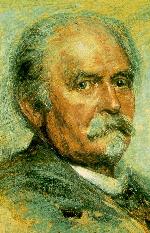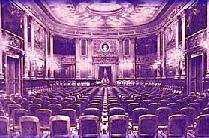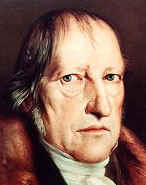
|
Felix Draeseke's "Symphonia Tragica" Part I Alan H. KrueckFelix Draeseke was born in 1835 in Coburg, Germany and died in Dresden in 1913. As the eldest son in a family of several generations of theologians, it was expected that he would become a Lutheran minister. There was little objection, however when, at age 16, Draeseke confirmed his intent of pursuing a career in music. He entered the Leipzig conservatory where his major teacher was Julius Rietz, but Draeseke, by his own confession, was not a particularly good student The most immediate result of this enthusiasm was the sketching of music for what later would become his first opera, König Sigurd. A little over a year later Draeseke made the acquaintance of Hans von Bülow in Berlin and earned approbation for the recently completed König Sigurd overtures. Upon showing this work to his father, Draeseke received the following criticism: "Your overture is not only not free of, but intentionally written under the influence of Wagner."[ii] Draeseke left the Leipzig conservatory in 1855 because, in his own words, "During my period of instruction I was considered a Wagnerian, something that could only prove a hindrance for me in my relations with not only Rietz, but especially with the [director of the conservatory] Schleinitz."[iii] In 1857 Draeseke was introduced to Liszt by von Bülow, showed Liszt what was finished of König Sigurd and gained an invitation to Weimar. By then Draeseke had actually heard a performance of his Jugendsinfonie in C major and several other orchestral works, all of which he later destroyed. Through his connections with Liszt, Draeseke managed his first visit to Wagner, which occurred in the summer of 1859 in Lucern. In his Autobiographische Skizzen Draeseke recalled the visit in the following cryptic manner: "Direct travel to Lucern via Lindau on July 28th. Strange reception, discomforting. Two weeks with Wagner."[iv] Later in his unpublished Lebenserinnerungen which stop in the year 1911, Draeseke remembered the visit in the following terms: "In general Wagner was not always congenial and as I now look back on that time, the first week and a half of our being together remains in my memory as a somewhat uncomfortable period. It wasn't seldom that he would appear highly nervous and would make no attempt at controlling his tongue, cursing conditions in Germany, to some degree with full justification, but on the other hand, cursing Liszt whom I esteemed highly and, as it seemed to me, without any reason."[v]
So much for the two men's personal recollections of each other at that time. Of greater significance in the historical assessment of Wagner's influence on Draeseke is Draeseke's account in his Lebenserinnerungen concerning his visit to Wagner's quarters the ninth evening of his stay; Draeseke writes: Witnessing the completion of the Tristan score was one of the most profound moments in the visit of the 23-year-old Draeseke, but not the only one. Draeseke reported in 1907 in an essay for the Signale entitled, Was ist die Not des heutigen Musikschaffens?, that during the visit in 1859, Wagner had brought him closer to understanding the essence of melody.[viii] In 1862 Draeseke left Germany to try his luck in Switzerland but he did not settle in the German-speaking part of the country, but rather, in the Suisse romande, pursuing his career by composing, teaching and performing. During his 14 years of Swiss residency he made numerous trips back to Germany but made Swiss friends as well, particularly Arnold Niggli in Zürich, who became and remained a firm admirer and apologist. During the years in Switzerland, Draeseke centered his activities around Lake Geneva, living in Geneva itself as well as Vevey, Yverdon, and Lausanne before returning to Germany in 1876. In later life Draeseke referred to his Swiss years as his "lost" or "wasted" years and gave few details about his life at the time. The record of this period is preserved in his letters to friends in the German-speaking world, for practically none of his French correspondence has been recovered: it is known that his engagement to a French-Swiss was ostensibly broken off because of parental sentiments during the Franco-Prussian War and that as early as 1865 Draeseke had been diagnosed with a hearing problem which led to almost total deafness by the time of his death. Although he lived in reasonable proximity to Wagner in Switzerland for at least five years, he visited Wagner only once more, at the embarrassing request of Hans von Bülow in connection with the Cosima affair. However bleak Draeseke may have painted his Swiss years, when he returned to Germany in 1876, he had either completed or had in progress a number of compositions, the most important of which were the Sonata quasi fantasia for Piano, Op. 6 in C# minor written between 1862-67, for which Liszt had nothing but unbounded praise, his G major Symphony, Op. 12 (No. 1), from 1868-72, and the first three movements of his Second Symphony, Op. 25, in F major, the fourth movement of which was finished after he had taken up residency in Dresden in 1876, the city in which he would remain until his death in 1913. One should take into consideration that, although we are concerned here with Draeseke the symphonist, the instrumental composer, Draeseke did compose in other realms and in consideration of this one is forced to circumspection in approaching Draeseke’s Symphonia Tragica.
If one ponders the criticisms of Draeseke's music up to 1862, an impression emerges that, especially regarding orchestration, Draeseke's perception of what was "modern" led him to a certain heavy-handedness, even bombast, in works requiring orchestra. Certainly this was the case with his Germania Marsch which caused a riot at the 1861 German musicians' convention in Weimar, a scene which a bemused Richard Wagner reported in Mein Leben, relishing the memory of an almost apoplectic Liszt screaming at the booing and hissing audience that it was not worthy of Draeseke's music. Draeseke himself recounted the scene in his Lebenserinnerungen: "Because of this piece (my Germania March) I was introduced as a terror for mankind and all over Germany newspapers hurried en bloc to let fall their sentence of damnation on Liszt's school, reserving for me, however, the description that I was the truly dangerous beast in the pack."[ix] When one examines the score of Draeseke's First Symphony one notices Lisztian-Wagnerian tendencies in the harmonies but also a decidedly individual approach to voice leading among the parts. The composer is certainly cognizant of the great models of symphonism left by Beethoven, Schubert, Mendelssohn and Schumann, but he is also applying insights gained from Wagner as evidenced especially in the First Symphony's magnificent slow movement (so proleptic of later Bruckner!) as well as in its trio-less scherzo. Commentators have found Draeseke's Second Symphony to represent a return to "classicism" if not an outright break with symphonism of the New German school. Technically it is not a symphony of classically formal definition, at least not in terms of the second half of the 19th century, since Draeseke employs a system of characteristic intervals to link the movements thematically - a fact overlooked by Peter Andreschke in his 1992 study, Notizen zu Draesekes 2. Symphonie, printed in Vol. 5 of the publications of the International Draeseke Society.[x] Because Draeseke euphemistically referred to his Second Symphony as his "classical” symphony, Andreschke organizes his essay - evidently believing no one will look at Draeseke's score - to condemn all previous analyses of the symphony as being in error -including this commentator's. Andreschke analyzes the two outer movements only and ignores the two inner ones, the march and scherzo, introduces political considerations mid-course which he traces to a 1923 essay by Georg Seywald in the Neue Zeitschrift für Musik which contains a two column "analysis" of Draeseke's F major symphony more poetic than technical and rests the case with the idea that since the symphony is non-programmatic it demonstrates Draeseke's regained "classical" allegiance. Andreschke's essay is a most ill-considered effort, one which recommends itself to a beginning seminar in musicology as a model of what not to do in making value judgments. Draeseke's own reference to "classical" orientation in his Second Symphony stems clearly from the composer's regard for Beethoven, particularly the Seventh and Eighth symphonies for, like Beethoven in those works Draeseke provides no genuine slow movement among his four - and it is precisely the Eighth Symphony of Beethoven which Draeseke cites in his Lebenserinnerungen as the symphony which he and Wagner played in four-hand piano arrangement in 1859 and for which Wagner provided commentary and insight regarding the essence of melody.
Contained in this interview are a number of facts pertinent to understanding Draeseke's philosophical and not just formal approach to composing the Tragica. First, there is Draeseke's revelation that he had in mind a clear philosophical basis from which to proceed, though not necessarily a programmatic one. Secondly, there is Draeseke's stated dissatisfaction with any resolution of the tragic in Beethoven's symphonies, particularly those which have been declared as doing so, the Eroica and the C minor symphonies. Thirdly, Draeseke renounces the use of vocal forces to aid him in achieving his ends, rejecting Beethoven's Ninth as well. All of these Beethoven symphonies fall into the popularized category of struggle-to-victory symphonies and all end affirmatively (and loudly) for whichever poetic reason suggested. Finally, Draeseke emphasizes the extraordinary weightiness of his final movement, a movement There are other musical factors that should be taken into consideration here for, although Draeseke's declared intent in the Tragica is to come to terms with representing the tragic in regard to Beethovenian attempts, the influence of Wagner's Geist cannot be ignored. Recognition of such [i]E. Roeder, Felix Draeseke. Der Lebens-und Leidensweg eines deutschen Meisters (2 vols., Dresden and Berlin, 1932, 1937); Vol. 1, p.49. With the exception of the quotation from Richard Wagner's My Life, all quotations from other German sources are translations from the original by the author of this article, Alan H. Krueck and, as such, are to be given appropriate reference citation. © Copyright by Alan H. Krueck: 1996, 2004 |
|
| [Home] [About IDG] [Discography] [Links] [Compositions] [Essays] [AK/Coburg] |
||
 and the conservative faculty distrusted his interests and instincts, for Draeseke, entering the conservatory in April 1852, attended a performance of Wagner's most recent opera Lohengrin directed by Liszt at Weimar during the Pentecost recess and, as contained in a letter to one of his aunts at the time - a letter quoted in Volume I of Erich Roeder's two volume biography of Draeseke - Draeseke confesses that he felt himself "...extraordinarily attracted to the direction which Wagner's music opens for art."
and the conservative faculty distrusted his interests and instincts, for Draeseke, entering the conservatory in April 1852, attended a performance of Wagner's most recent opera Lohengrin directed by Liszt at Weimar during the Pentecost recess and, as contained in a letter to one of his aunts at the time - a letter quoted in Volume I of Erich Roeder's two volume biography of Draeseke - Draeseke confesses that he felt himself "...extraordinarily attracted to the direction which Wagner's music opens for art."
 The three instrumental works previously mentioned - the piano sonata and the first two symphonies - provide important reference points regarding the development of Draeseke's own very singular style. The C-sharp minor piano sonata is actually a summary work among Draeseke's youthful strivings and a transitional one at the same time. It is one of his harmonically most adventurous compositions, daringly unconventional to the point that critics saw its novelty as contrived and forced; its cyclical form enclosing a funeral march and waltz-scherzo and its concluding E major tonality put it in the avant-garde of the New German School and caused Liszt to declare it - not only when it was new but later in his life as well - to be the most significant piano sonata since Schumann's G minor. Despite the extravagance of invention the sonata is a work of masterful discipline, a quality not often cited in the works of a young composer dubbed der Recke by his colleagues in the Lisztian avant-garde.
The three instrumental works previously mentioned - the piano sonata and the first two symphonies - provide important reference points regarding the development of Draeseke's own very singular style. The C-sharp minor piano sonata is actually a summary work among Draeseke's youthful strivings and a transitional one at the same time. It is one of his harmonically most adventurous compositions, daringly unconventional to the point that critics saw its novelty as contrived and forced; its cyclical form enclosing a funeral march and waltz-scherzo and its concluding E major tonality put it in the avant-garde of the New German School and caused Liszt to declare it - not only when it was new but later in his life as well - to be the most significant piano sonata since Schumann's G minor. Despite the extravagance of invention the sonata is a work of masterful discipline, a quality not often cited in the works of a young composer dubbed der Recke by his colleagues in the Lisztian avant-garde.  Ten years would pass between the completion of Draeseke's Second Symphony and the beginning of his Third Symphony, Op. 40, in C major, the Symphonia Tragica. The composer had actually been contemplating a third symphony even before the completion of the second. In 1907, when Arthur Nikisch was preparing a performance of the Symphonia Tragica with the Leipzig Gewandhaus Orchestra, the critic Eugen Segnitz visited Draeseke and asked for details concerning the Tragica's origins. Draeseke replied as follows:
Ten years would pass between the completion of Draeseke's Second Symphony and the beginning of his Third Symphony, Op. 40, in C major, the Symphonia Tragica. The composer had actually been contemplating a third symphony even before the completion of the second. In 1907, when Arthur Nikisch was preparing a performance of the Symphonia Tragica with the Leipzig Gewandhaus Orchestra, the critic Eugen Segnitz visited Draeseke and asked for details concerning the Tragica's origins. Draeseke replied as follows:
